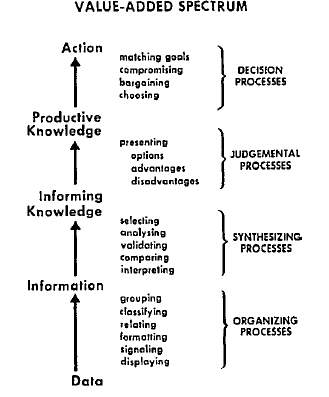Value-added Process[加值程序]
Key person: Robert S. Taylor
Questions: 此理論欲解釋的問題(1986 .pp.1-2)
- What does an information system do for human beings to justify its cost?
資訊系統為人類做了什麼,以證明其成本是有效的? - Can we relate the system costs (value added in the economist's term) to the user enhancements added by the system (value added in the context of this book)?
我們能將系統成本(經濟學上的加值)關聯到系統對使用者增強的部份(本書中所陳述的加值)? - What will be the cost in time, effort, and money that users, sitting in particular environment with particular problems, must invest to obtain useful information from any particular system?
在特定環境中,有著特定問題的使用者,必須要投入那些時間、努力與金錢的成本,才能從系統中獲得有用的資訊?
Assumptions::
- the information system is a operating information system, its practice-driven and in “ordinary contexts of practical action”.
- user-driven model, not content-driven or technology-driven model
命題(Arguments):
- 資訊系統是: (a)一加值程序。(b)任務與問題的資訊環境引發對解決方案資訊的需求。
- Definition of information system: 資訊系統是能增強訊息潛在使用性的程序。 “information systems are a series of formal processes by which the potential usefulness of specific input messages being processed is enhanced.” 因此,通過此一系統的產品被加值了。
- 系統對訊息經過不同程序處理而加值。此一系列加值程序稱為加值續譜(value-added spectrum)
- 訊息的價值取決於使用者對此訊息利用的可能性(可用性)。
加值續譜
- 資料:基本的符號,用來稱呼形成某個時間點上的實體的狀態 “that designate the states (conditions) that characterize an entity of some point in time.”
- 資料在系統內會依脈絡予以各種適切的標名(label)。透過這些標名,資料被加上各種屬性。 就資料處理方面,每一個標名或屬性是一個欄位(field),欄位的集合是一筆紀錄(record),紀錄的集合是一個檔案(file)。這些都是資料。
- 缺乏下一步的程序,這些資料是沒有用途的。
- 每一個系統需定義自身的資料為何。
- indexing, abstracting, 都是為資料加值的處理程序。
- 資訊:彼此有關係的資料。資訊不只是標名了的資料,而是資料間的結構與關係,以及更重要的,建立這些關係與結構的規則(rules)與條件(conditions)
- informing knowledge[知曉性知識]: 以知道(inform)為目的的知識。能教育的,知會,為個人的,專業的,文化的知識。其程序為:挑選、分析、判斷、比較、詮釋。
- productive knowledge[生產性知識]: 以行動(action)或決策導向的知識。並非所有知識都會成為生產性知識,許多知識仍舊是知曉性知識。透過判斷程序(judgment process),呈現出各種選項以及權衡其優缺點,知識由知曉轉為生產性。
價值
value assess[價值估算] = axiology[價值論]
- 區分兩種詮釋性價值:
- 訊息內容資訊/知識的潛在價值。由資訊環境決定其價值的標準,因此對環境的瞭解可以提供系統管理者更理解特定脈絡下的資訊價值。
- 提供訊息服務的價值。在資訊系統中的加值,協助客戶選擇適切的有用性資訊內容。
- 價值的特性:
- 價值不隱含在訊息之內,也不由訊息承載
- 訊息只有在脈絡中才具有價值
- 「使用者」根據「可用性」決定訊息的價值。因為使用者處於一利用訊息以解決問題或執行任務的特定環境。
- 訊息因此具有價值的潛在可能。
- 「可用性(usefulness)」表示使用者選用一特定訊息,以 (a)立即的使用它;(b)儲存訊息以作為未來潛在的效用
- 因為訊息具有潛在價值,因此「加值程序(value-added process)」被定義為:
- 挑出訊息的潛在價值
- 連結到潛在特定環境的需求
- 未來導向
- 「從長期來看,所有獲取、處理、儲存、傳佈訊息的資訊系統,本質上都是在為下一分、下一天、或下一年這些訊息將會有用的一種賭博。」
- 「因此,加值的概念也必須是一種未來導向的投機(冒險, risk)。為了提高在此投機中成功的機率,本文認為需更注意使用者及其所處的環境。」
References
- Taylor, R. S. (1982). Value-added processes in the information life cycle. Journal of the American Society for Information Science, 33(5), 341-346.
- Taylor, R. S. (1986). Value-added processes in information systems. Norwood, N.J.: Ablex.
- Rosenbaum, H. (1993). Information use environments and structuration: Towards an integration of taylor and giddens. Proceedings of the ASIS Annual Meeting, 30, p235-245.
- Rosenbaum, H. (1996). Structure and action: Towards a new concept of the information use environment. Paper presented at the Proceedings of the 59th Annual Meeting of the American Society for Information Science.


